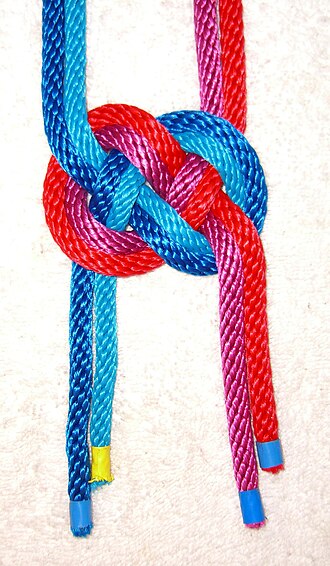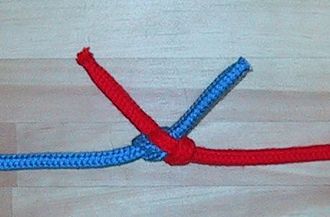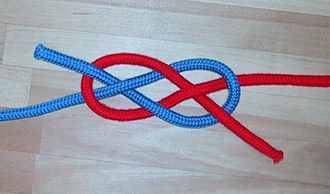| (9 intermediate revisions by the same user not shown) | |||
| Line 16: | Line 16: | ||
== Tying == | == Tying == | ||
| + | [[Image:Double coin knot.jpg|thumb|This decorative knot has the same [[topology]] as the carrick bend above, as can be seen by tracing the paths of the outermost blue and red lines.]] | ||
See article/pictures. | See article/pictures. | ||
Considered to be one of the most secure bends. Will not jam (i.e. can be untied easily) even after carrying a significant load and/or getting wet. | Considered to be one of the most secure bends. Will not jam (i.e. can be untied easily) even after carrying a significant load and/or getting wet. | ||
| − | Unless the two free ends are lashed to the two standing parts, the knot will collapse into a different shape under load, which does not reduce its strength in any way. | + | Unless the two free ends are lashed to the two standing parts, the knot will collapse into a different shape under load, which does not reduce its strength in any way.It is very important when lashing, that both ends are lashed, or the bend will slip. |
| + | |||
| + | In the decorative version, both standing ends enter from the top and | ||
| + | both working ends exit from the bottom, with the knot being flattened | ||
| + | out (though the [[topology]] remains unchanged). In this configuration | ||
| + | the knot is known as the ''Josephine knot'' ([[macrame]]) or | ||
| + | ''double coin knot'' ([[Chinese knotting]]). It is often tied in double lines for a flatter, more elaborate appearance. | ||
| + | |||
| + | ==See also== | ||
| + | * [[List of bend knots|List of bends]] | ||
| + | * [[List of knots]] | ||
| + | |||
| + | ==External links== | ||
| + | * [http://www.animatedknots.com/carrick/ Grog's Animated Knots: How to tie the carrick bend] | ||
[[Category:Knots]] | [[Category:Knots]] | ||
| − | [[de: | + | |
| + | [[de:Trossenstek]] | ||
Revision as of 10:53, 24 March 2006
Canonical Name: Carrick Bend
Category: bend
Efficiency: Unknown %
Origin
Ancient. The name comes from Carrick Roads - a large natural anchorage by Falmouth in Cornwall, England. Carrick is also a local government district in Cornwall and the knot is the emblem of Carrick District Council.
The name is also said to have been derived from the Carrack, a medieval type of ship.
Uses
Securing two lines, particularly heavy ropes or decorative purposes.
Tying

See article/pictures.
Considered to be one of the most secure bends. Will not jam (i.e. can be untied easily) even after carrying a significant load and/or getting wet.
Unless the two free ends are lashed to the two standing parts, the knot will collapse into a different shape under load, which does not reduce its strength in any way.It is very important when lashing, that both ends are lashed, or the bend will slip.
In the decorative version, both standing ends enter from the top and both working ends exit from the bottom, with the knot being flattened out (though the topology remains unchanged). In this configuration the knot is known as the Josephine knot (macrame) or double coin knot (Chinese knotting). It is often tied in double lines for a flatter, more elaborate appearance.


